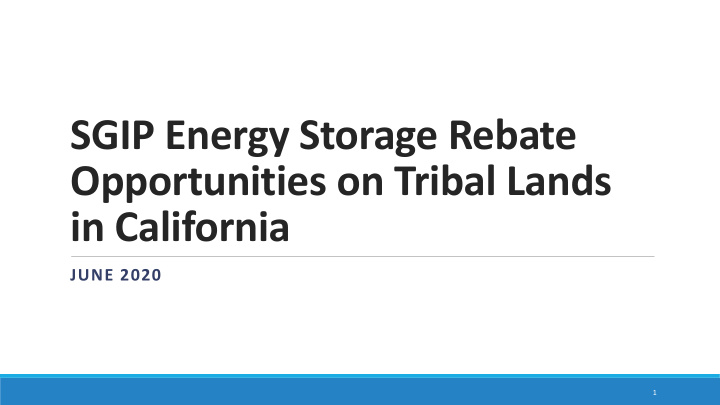



SGIP Energy Storage Rebate Opportunities on Tribal Lands in California JUNE 2020 1
Agenda ➢ Introductions ➢ Overview and Benefits of Energy Storage Systems for Buildings ➢ CPUC SGIP Battery Rebate Program Overview ➢ Recent SGIP Battery Rebate Program Changes ➢ Non-Residential Battery Opportunities for Tribes ➢ Residential Battery Opportunities on Tribal Lands ➢ Tribal Community SGIP Battery Rebate Initiatives ➢ Conclusion 2
Introductions Josh Simmons Shawn Jacobson President, Principal Consultant VP of Operations Prosper Sustainably Swell Energy (805) 617-5685 (805) 804-7965 jsimmons@prospersustainably.com shawn@swellenergy.com www.prospersustainably.com www.swellenergy.com/ 3
Overview and Benefits of Energy Storage Systems for Buildings 4
5
Energy Storage System Benefits ➢ Maintain Power During Outages (off-grid) – Depends on size of battery, level of charge, and electricity usage – OPTIONAL: Can be paired with solar for off-grid recharging – Without battery, solar typically shuts off during a grid outage ➢ Save Money of Electric Bills (on-grid)* – Buy lower cost off-peak period power (and/or charge with solar power) – Use off-peak/solar power during higher cost peak periods – *Depends on usage patterns and utility rate schedule 6
Time of Use Pricing Example 7
CPUC SGIP Program Overview & Recent Changes 8
SGIP Battery Rebate Program ➢ CPUC = California Public Utilities Commission – https://www.cpuc.ca.gov/sgip/ ➢ SGIP = Self Generation Incentive Program – https://www.selfgenca.com/ ➢ SGIP launched in 2011 ➢ Rebates for emerging energy storage & generation technologies ➢ Funded by IOU ratepayers ➢ Rebates only available to fund contributors (i.e. IOU customers) – PG&E, SCE, SDG&E, and SoCal Gas 9
Recent Changes to SGIP ➢ CPUC Decision 19-09-027 (September 12, 2019) – Supplement by D.20-01-021 and other subsequent decisions ➢ Equity Budget Rebate for Energy Storage Increased to $0.85/Wh* – “Equity Budget Projects” ➢ Equity Projects in High Fire Threat Districts (HFTDs) Add $0.15/Wh* – “Equity Resilience Budget Projects” – HFTD Maps: https://ia.cpuc.ca.gov/firemap/ (must be in Tier 2 or 3) – Alternative to HFTD Qualification: Facility experienced 2 or more PSPS outages ➢ No Equity or Equity Resilience Budget “Step Downs” ➢ Equity Resilience Budget Significantly Increased *Subject to additional requirements and restrictions 10
Recent Changes to SGIP ➢ All CA Indian Lands defined as Disadvantaged Communities (DACs) – DAC status used to be determined only by CalEnviroScreen ➢ CA Indian Lands = Federally Recognized Indian Trust Lands – Includes privately-held inholdings owned by tribe or at least one tribal member 11
Non-Residential Battery Opportunities for Tribes 12
Non-Residential SGIP Opportunity ➢ Equity Resiliency Budget Rebate $1.00 per watt hour of energy storage: – Certain facilities are eligible for Equity Resilience budget:* – Police stations; fire stations; emergency response providers (fire, law, medical, public safety, etc.); emergency operations centers; 911 call centers; medical facilities; nursing homes; blood banks; health care facilities; gas, electric, water, wastewater, or flood control facilities; jails and prisons; IOU designated PSPS assistance centers; cooling centers; homeless shelters; grocery and corner stores; markets and supermarkets; foodbanks; independent living centers – Facilities must be located in in HFTDs or experienced 2+ PSPS events ➢ Rebate can offset 100% of the battery system cost – 100% rebates for most of the eligible Rincon, Pala, and San Pasqual facilities ➢ Rebates available starting on May 12, 2020 *Subject to additional requirements and restrictions 13
Residential Battery Opportunities on Tribal Lands 14
Residential SGIP Opportunity Eligibility of residential projects on CA Indian Lands includes: ➢ Homes with electric pumps for drinking water (regardless of income) ➢ Homes with medical equipment, on medical baseline rates, or notified utility of life-threatening illness/condition (regardless of income) ➢ Homes with GRID Alternatives solar PV systems (regardless of income) – Customer previously qualified for SOMAH, MASH, SASH or DAC-SASH programs ➢ Homes that meet certain income requirements – The exact income thresholds are pending – Current off-reservation limits are 60% of median income for area – Proposed income thresholds are based on California Alternate Rates for Energy (CARE) enrollment requirements 15
CPUC Proposed Income Limits Household size Income Eligibility Upper Limit 1-2 $34,480 3 $43,440 4 $52,400 5 $61,360 6 $70,320 7 $79,280 8 $88,240 Each Additional $8,960 Person 16
CPUC Battery Rebate Program ➢ Equity Resilience Budget Rebate → $1.00/Wh ➢ Cost of 2 Tesla Powerwall System (10 kW / 26.4 kWh) = ~$26,000 ➢ Rebate for 2 Tesla Powerwall System = up to $26,400 ➢ Residential SGIP went into effect on May 1, 2020 – Rebate applications are being reviewed and approved on a first come, first serve basis. A high volume of applications is expected (possible delays). – The rebate budget is large, but not unlimited. 17
Tribal Community SGIP Battery Rebate Initiatives 18
Tribal Battery Rebate Initiatives ➢ Tribes can work with any battery installer in pursuing rebate ➢ Prosper Sustainably + Swell Energy Partnership – Prosper Sustainably = Tribal Liaison – Swell Energy = Largest Home Battery Installer in California ➢ Current Tribal Initiatives (Residential and Small/Medium Non-Res.) – San Pasqual, Rincon, Pala, Yurok ➢ Tribal Initiative Features** – Tribal Community Meeting(s) and/or Webinar(s) – Rebate application and collection handled by Swell – No out-of-pocket costs (for qualifying equity resilience projects) 19
Thank You! Questions? 20
Recommend
More recommend